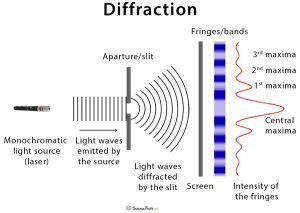

Light that passes around the hair spreads out, overlaps, and produces a diffraction pattern.

Thin objects, such as a strand of hair, also diffract light. X-Ray Diffraction Crystallography: Introduction, Examples and Solved Problems by Waseda, Yoshio Matsubara, Eiichiro Shinoda, Kozo at .uk - ISBN. In fact, the angle between two adjacent dark bands in the diffraction pattern is inversely proportional to the width of the slit. The narrower the slit, the more the light spreads out. This different amount of bending gives the blobs their colored edges: blue on the inside, red on the outside. Red light, for instance, has a longer wavelength than blue light, so it bends more than blue light does. The angle at which the light bends is proportional to the wavelength of the light. Where the trough of one wave overlaps with the crest of another wave, the waves cancel each other out, and you see a dark band. Where the crest of one wave overlaps with the crest of another wave, the two waves combine to make a bigger wave, and you see a bright blob of light. The light waves that go through the slit spread out, overlap, and add together, producing the diffraction pattern you see. The black bands between the blobs of light show that a wave is associated with the light. Rotate each object while you look through it. Look at the light through a piece of cloth, a feather, a diffraction grating, or a piece of metal screen. Rotate the hair and watch the line of blobs rotate. Move the hair until it is between your eye and the light source, and notice that the light is spread into a line of blobs by the hair, just as it was by the slit. Stretch a hair tight and hold it about 1 inch (2.5 cm) from your eye. Notice that the blobs have blue and red edges and that the blue edges are closer to the light source. As you squeeze the slit together, the blobs of light grow larger and spread apart, moving away from the central light source and becoming easier to see. If you look closely you may see that the line is composed of tiny blobs of light. While looking through the slit, rotate the pencils until they are horizontal, and notice that the line of light becomes vertical. Notice that there is a line of light perpendicular to the slit. Squeeze the pencils together, making the slit smaller. A microphone on the headphones detects any low-level noise around you, and then the headphones emit sound waves into your ears that destructively interfere with the ambient noise.

Hold both pencils close to one eye (about 1 inch away) and look at the light source through the slit between the pencils. Noise-cancelling headphones work on the principle of destructive interference of sound waves. The tape wrapped around one pencil should keep the pencils slightly apart, forming a thin slit between them, just below the tape. Hold up the two pencils, side by side, with the erasers at the top. Place the light on a stable surface at least one arm’s length away from you.


 0 kommentar(er)
0 kommentar(er)
